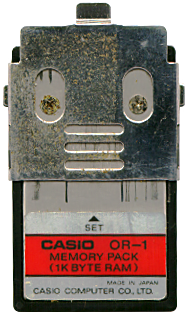
Terminated: unknown
From its manual:
Thank you very much for purchasing the CASIO PB-100. This unit is a "handy type" personal computer which is excellent for those who are beginning to learn about computers.
There is also a TANDY version of this device, the TRS-80 PC-4.
Thank you very much for purchasing the CASIO PB-100. This unit is a "handy type" personal computer which is excellent for those who are beginning to learn about computers.
It can be used as a calculator in RUN mode. Scientific functions have to be typed to use them. Calculations, after being evaluated, can not be replayed, there is however an ANS key to produce the last result and use it in new calculations.
When performing calculations, true algebraic logic is used, so "- 12 + 6 * 9" gives the correct answer of "42". Brackets can also be used, and they do not need to be closed, so "1 * ( 2 + 3" is correctly evaluated to "5".
The display can be configured to display a specific required accuracy. This is done using the "SET"-command. "SET E" to determine the number of effective positions. "SET F" can be used to set the number of decimal positions. Use "SET N" to return back to "normal".
 For programming, the built-in memory of 1 kB leaves 544 programming steps and 26 memories.
Using the "DEFM" command the memory can be segmented exchanging programming steps
for up to 94 memory locations. There is also a 1 kB OR-1 optional RAM pack expanding the
default configuration to 1,568 programming steps and up to 222 memory locations.
For programming, the built-in memory of 1 kB leaves 544 programming steps and 26 memories.
Using the "DEFM" command the memory can be segmented exchanging programming steps
for up to 94 memory locations. There is also a 1 kB OR-1 optional RAM pack expanding the
default configuration to 1,568 programming steps and up to 222 memory locations.
The standard 26 variables A-Z can only be used as either a number or a string. String variables can store a maximum of 7 characters. There is one special string variable called "$" however, which can store 30 characters. This is handy when used in operations where strings are added together.
For programming there are 10 distinct program areas, P0 - P9. Programs can be edited or erased in WRT mode. To erase the selected program type "CLEAR". To erase all programs type "CLEARA".
As usual a BASIC program use line numbers. The maximum line length (including the line number) is 62 characters. Editing programs is a little cumbersome due to the lack of up/down arrow keys. Type "LIST" to start listing, approximately 2 seconds per line. Listing can be stopped using the STOP key and resumed by pressing the EXE key.
A neat feature is how subroutines work. They can be nested a maximum of 8 levels deep. A subroutine call can be to a line number, or to one of the other programs, e.g. "GOSUB #4" will call P4 as a subroutine. To make it even more powerful, the value passed to "GOSUB" can also be the result of a calculation!
Note that there is a slight yellow colour hue on this Pocket Computer’s scan. At first I assumed that this was due to the original plastic protective foil still being present but since my CASIO PB-200 is also displaying the same hue even stronger, I'm assuming it is discoloration due to aging.
Succeeded by the CASIO PB-110, CASIO PB-120 and the CASIO PB-200 (with 1 kB extra RAM).